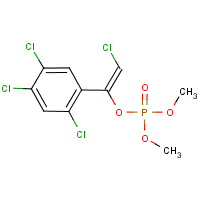Tetrachlorvinphos
Agent Name
Tetrachlorvinphos
CAS Number
22248-79-9
Formula
C10-H9-Cl4-O4-P
Major Category
Pesticides

Synonyms
(Z)-2-Chloro-1-(2,4,5-trichlorophenyl)ethenyl dimethyl phosphate; (Z)-2-Chloro-1-(2,4,5-trichlorophenyl)vinyl dimethyl phosphate; 2,4,5-Trichloro-alpha-(chloromethylene)benzyl alcohol, dimethyl phosphate; 2-Chloro-1-(2,4,5-trichlorophenyl)vinyl dimethyl phosphate; 2-Chloro-1-(2,4,5-trichlorophenyl)vinyl phosphoric acid dimethyl ester; Appex; CVMP; Debantic; Dietreen; Dimethyl 2,4,5-trichloro-alpha-(chloromethylene)benzyl phosphate; Dimethyl-1-(2,4,5-trichlorophenyl)-2-chlorovinyl phosphate; Dust M; Gardcide; Gardona; O-(2-Chlor-1-(2,4,5-trichlorophenyl)vinyl)-O',O''-dimethylphosphate; OMS-595; ROL; Rabon; Rabond; SD 8447; Shell SD 8447; Stirofos; Stirophos; Stitifos; Tetrachlorvinfos; Vinfos; Phosphoric acid, 2-chloro-1-(2,4,5-trichlorophenyl)ethenyl dimethyl ester, (Z)-; Phosphoric acid, 2-chloro-1-(2,4,5-trichlorophenyl)vinyl dimethyl ester, (Z)-; 2-Chloro-1-(2,4,5-trichlorophenyl)vinyl dimethyl phosphate; 2-Chloro-1-(2,4,5-trichlorophenyl)vinyl phosphoric acid dimethyl ester; Benzyl alcohol, 2,4,5-trichloro-alpha-(chloromethylene)-, dimethyl phosphate; Phosphoric acid, 2-chloro-1-(2,4,5-trichlorophenyl)ethenyl dimethyl ester; Phosphoric acid, 2-chloro-1-(2,4,5-trichlorophenyl)vinyl dimethyl ester; [ChemIDplus] UN3077
Category
Organophosphate Insecticides
Description
Colorless or off-white solid with a mild chemical odor; [HSDB]
Sources/Uses
Used against flies in dairies and livestock barns, ectoparasites on poultry, pests of stored products, and other insects that damage forests, crops, and pastures; [HSDB]
Comments
May cause irritation; A cholinesterase inhibitor; Effects in high-dose animal studies include convulsions; [MSDSonline] “The average of two baseline respective cholinesterase activity determinations three days apart, with no exposures to enzyme inhibiting pesticides for at least 30 days, is recommended for each worker prior to exposure to cholinesterase inhibitors because of large inter-individual differences in published baseline values. To be established at least once a year. Removal from workplace exposures is recommended until the cholinesterase activity returns to within 20% of baseline.” Causes allergic contact dermatitis (DSEN); TLV Basis = liver, kidney and thyroid effects; [ACGIH TLVs and BEIs]
Reference Link #1
Biomedical References
Exposure Assessment
BEI
Acetylcholinesterase activity in red blood cells = 70% of individual's baseline; Butylcholinesterase activity in serum or plasma = 60% of individual's baseline; Sample at end of shift; [TLVs and BEIs]
Skin Designation (ACGIH)
Yes
TLV (ACGIH)
0.5 mg/m3, inhalable particulate matter
Vapor Pressure
4.2E-08 mm Hg
Lethal Concentration
LC50 (mice) > 1,500 mg/m3/4h
Explanatory Notes
The Guide in the Emergency Response Guidebook is for "Environmentally hazardous substances, solid, n.o.s."
Adverse Effects
Hepatotoxin
Hepatoxic (a) from occupational exposure (secondary effect) or (b) in animal studies or in humans after ingestion
Nephrotoxin
Yes
IARC Carcinogen
Not classifiable
ACGIH Carcinogen
Confirmed Animal
Other Poison
Organophosphate
Diseases, Processes, and Activities Linked to This Agent
Diseases
Occupational diseases associated with exposure to this agent:
Processes
Industrial Processes with risk of exposure: